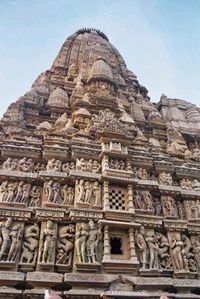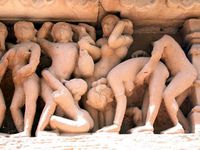UnNews:Risque sand castle contest entry disqualified
4 September 2007
CASCO, Maine -- In building a replica of a typical Khajuraho temple as his entry in the “Castle to the Sun” sand castle contest, Ed Jarrett thought he was doing his part in a charitable effort to raise funds for terminally ill children, but, much to his shock and disappointment, he was told that his structure has been disqualified. “It’s too risqué,” he was informed.
His replica of the famous--some might say infamous--ancient Indian temple is a miniature, but it is a huge miniature. The edifice stands 31 feet, seven inches tall, took 1000 volunteers two months to create, and required 40 dump trucks full of sand to build.
Stephen King plans to feature Jarrett’s new addition to Maine’s seacoast in an upcoming novel, the title of which, the author says, is derived from a Jimi Hendrix song: “Castles Made of Sand.” King refused to divulge anything more about the novel’s plot than to admit, “There will be ghosts in it.”
The Guinness Book of World Records is in the process of verifying Jarrett’s claim that his creation is the tallest sand castle ever built.
Jarrett organized the contest as a means of raising funds for terminally ill children, he told Unnews’ reporter Lotta Lies because “somebody had to do it” and he’s always seen himself as a hero and a good Samaritan and a wonderful person with a big, generous heart. “I’m like Mattel,” he said, comparing himself to the toy company. “I’m swell.”
The Khajuraho temples were dedicated to either the Jain pantheon or to the Hindu deities Brahma, Vishnu, and Shiva, known as the “terrible threesome.” The exterior of these temples are replete with erotic carvings that involve both heterosexual and homosexual couples coupling and threesomes involved in erotic pornographic activities of various sorts, anal, oral, and otherwise. Some figures involve bestiality as well, for good measure.
Indians claim that the statues represent “art,” but many of the Islamic faith consider them obscene and blasphemous. “The figures are just another of the many reasons for Jihad,” Sheik Mohammed Ali Mohammed said.
In constructing his replica of a typical Khajuraho temple, Jarrett was as faithful to capturing the likenesses of the sexual couples as he was in reflecting the scale of the houses of worship. As a result, his sand castle has been called “too risqué” to be admitted to the very contest that Jarrett himself organized, and officials have ordered the edifice to be bulldozed.
The contest’s judges gave Jarrett the option of removing the offending figures, but he refused. “As an artist, I have integrity,” he said. When he refused to censor his work, the officials decided to eliminate his entry on the grounds that it represents a temple rather than a castle per se. However, before destroying the temple, judges ordered that several hundred full-color photographs, from various angles, be taken as a record of Jarrett’s work and for the judges’ own “personal use.”
Jarrett defends his sculpture by saying, “It’s not sacrilege. It’s not blasphemy. It’s not pornography. It’s not obscenity. It’s art and architecture.”
“I wish they’d reconsider,” 10-year-old Edwin Meese said. “The girls might be made of sand, but they’re better looking than my girlfriend. Besides, the sculpture’s a sort of Kama Sutra in stone, and, when you’re 10 years old, there’s a lot to learn about, uh--well, you know--the, uh, birds and the bees.”
Source[edit | edit source]
- Lotta Lies "Kama Sutra in sand blasted as “blasphemous”" Instant News, .008 nanoseconds ago


